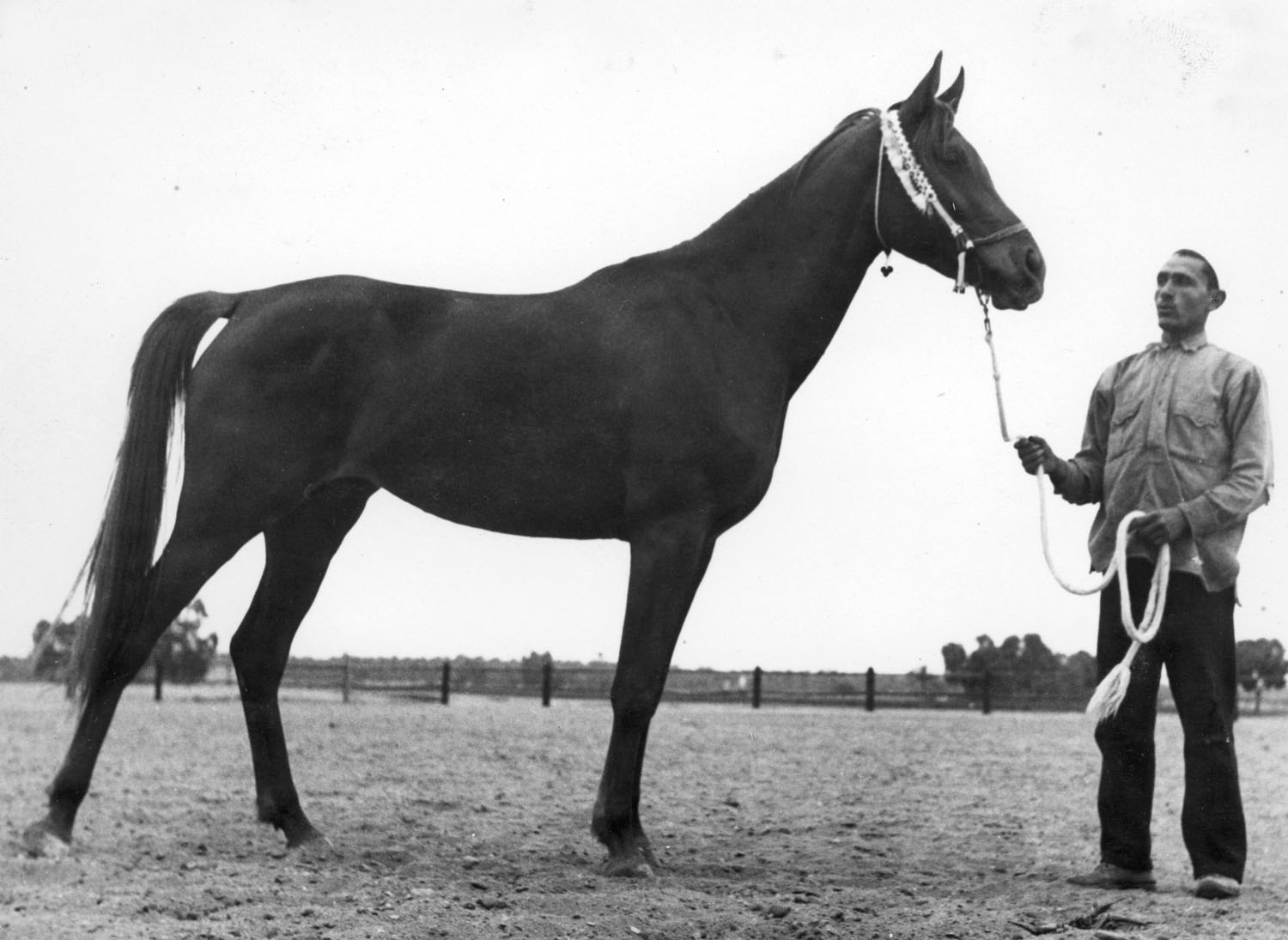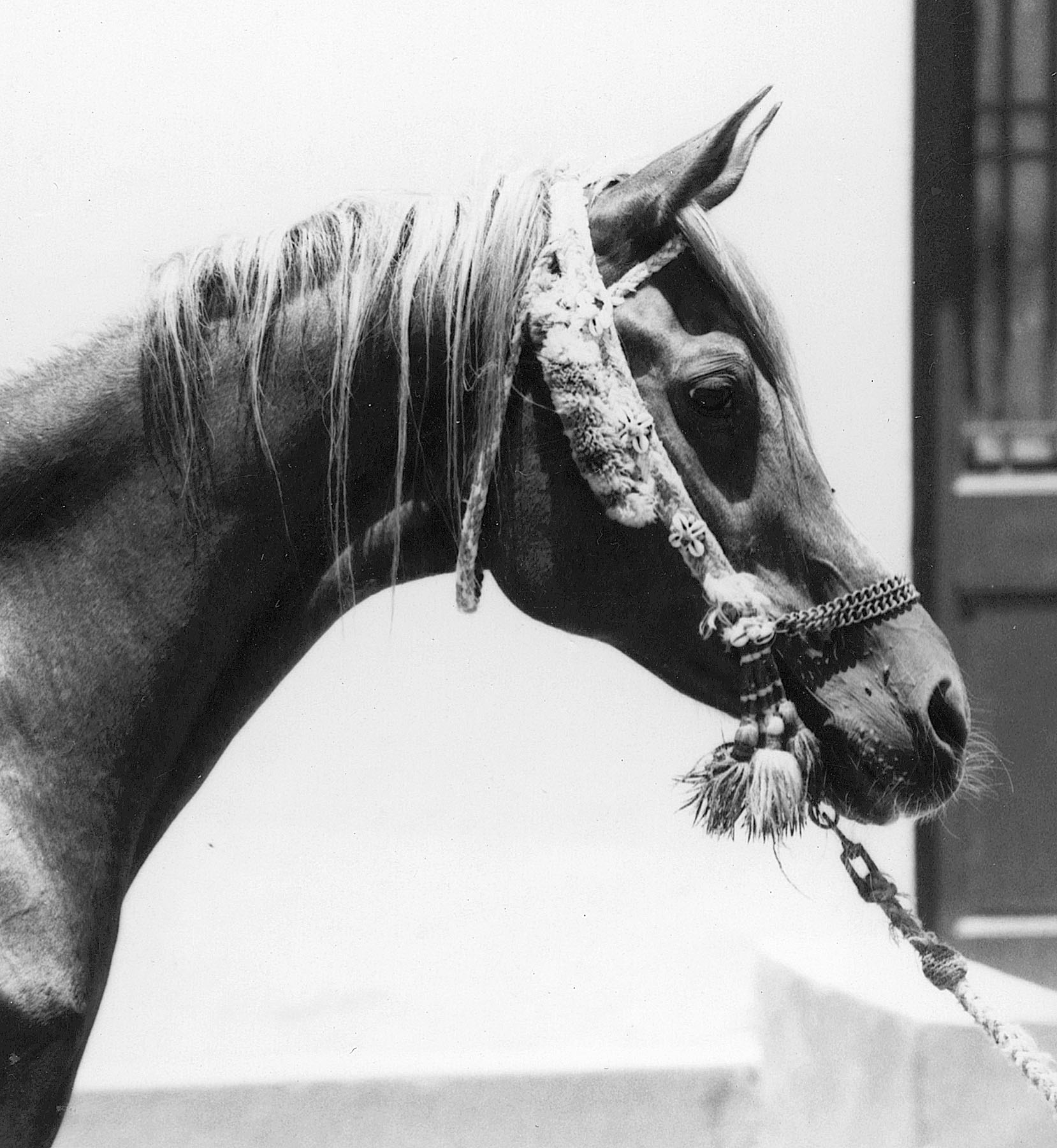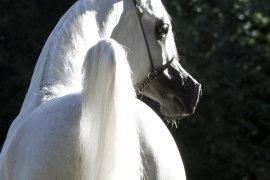Just for fun let's look back on the female line of Om Dalal, one of the most celebrated Saklawi Jidran female lines in Egyptian breeding and, through pictures, get a feel for its influence.
Om Dalal became a broodmare for Prince Mohammed Ali. She produced the stallion Samhan of which there is only one known picture of him in old age. He appears to be a handsome horse with a rather masculine face, not extreme by any means. He is the sire of Ibn Samhan, who sired Balance a horse of high conformational quality and the greatest Egyptian race horse of the past as well as a sire of quality mares. Balance was sire and grandsire of a good many race winners so he was a proven performance horse but he was a plain looking type. Ibn Samhan also sired the stallion Zarife (x Mahroussa) and the mare Bint Saada (x Saada) who were imported to the U.S. and became ancestors in many endurance pedigrees and American bred performance horses. In Egypt Ibn Samhan also sired Kheir (x Badouia) who raced well and sired race winners. So it would be realistic to say that Om Dalal's son Samhan was primarily a source of performance quality though not necessarily associated with beauty. Nonetheless it is important to have such "performance" potential included in the ancestry of this family.
Dalal [Al Zarka] 1903 grey mare by Rabdan x Om Dalal,
at Prince Mohammed Ali's stable.
All the spendour of this famous Saqlawi Jidran line begins here.
Forbis collection.
On the female side, Om Dalal's daughter Dalal (also called Dalal Al Zarka - the grey Dalal) a full sister to Samhan, was an attractive mare of refinement, a bit long in body but good depth, long forearms, with desirable short canon bones, and nice expressive eyes. Dalal produced quality but also proved to be a line of great beauty increasing with each generation.

Samhan (Rabdan x Om Dalal) pictured here in very old age.
His son Ibn Samhan is the sire line of some of the greatest
and fastest race winners in Egypt.
Forbis collection.
Dalal confirmed her merit as a broodmare through her son Gamil Manial sire of Mansour who is famed for his sons Nazeer and Sheikh El Arab. Dalal's daughters were also a significant influence. Dalal's daughter Mahbouba is granddam of Mr. Babson's import, the previously mentioned Bint Saada (who has two crosses to Om Dalal). Dalal's daughter Ghazalah (who also has two crosses to Om Dalal) became a broodmare for the Inshass Royal stud.
Dalal's daughter Khafifa (by Ibn Samhan) produced Medallela, whose beautiful daughter Wanisa is celebrated for producing Moniet El Nefous.

Balance (Ibn Samhan x Farida)
one of Egypt's greatest race horses.
Not a beautiful horse but a good one.
His daughters became very significant in Egyptian breeding.
Forbis collection.
As you look at the picture of the young Medallela you can already see emerging a kind of refinement of this family. This type of head is a bit longer but with the distinct prominent forehead "jibbah" gracefully curving below into a distinct dish in the face and tapering to a soft rounded muzzle.
As you look at the picture of Medallela's daughter Wanisa (x Sheikh El Arab) as a filly, you can see the refinement and beauty of facial details and lovely ear shape. The face is now longer and more refined. This look is transmitted to her daughter Moniet El Nefous. Wanisa has 3 lines to Om Dalal. Breeding Wanisa to Shahloul to produce Moniet El Nefous represents the marriage of two celebrated Saqlawi Jidran families, Om Dalal and Bint Radia.

Gamil Manial (Saklawi II x Dalal) pictured here in old age.
He is the grandsire of legendary sires Nazeer and Sheikh El Arab.
Forbis collection.
Studying the portrait of Moniet El Nefous taken by Judi Forbis in Egypt you can see that she was not just a mutation of nature but also the distillation of all the beauty of this female line that seemed to increase with each generation. In the details of Moniet El Nefous one sees the graceful lengthening of facial features, the refined dry skin showing dryness and detail, an enhanced and more elegant ear shape, and more expressive eyes with just a bit of white in the corners giving a more "human like" expression. This is a portrait of the evolution of beauty in the Om Dalal family with Moniet El Nefous being the ultimate conclusion.
Because her look was so strong for generations, Moniet El Nefous became a transformational figure in Arabian breeding much the way Nazeer did. It seemed to many that a "new archetype" look for the Arabian horse had emerged as her descendants and those of Nazeer were sought after by many in the desire to produce more of this look that we still see today.

Medallela (Awad x Khafifa out of Dalal)
as a young mare showing the increasing refinement
evolving from Dalal's family.
Though taken from a low angle,
the "dished" face with bulging "jibbah" is already apparent.
Forbis collection.
There are those who argue that such a type of head as Moniet's is an aberration and would be found elsewhere or in the desert among Bedouin tribes. Maybe not in the extreme, but I am not one to make such sweeping generalizations. I remember seeing the straight Babson Egyptian mare Aradan in old age and being taken by how much she resembled the Moniet El Nefous look, even though she had no Om Dalal or Moniet in her pedigree.

Wanisa (Sheikh El Arab x Medallela), shown here as a filly.
With three crosses to Om Dalal one can already see
that the look of Moniet El Nefous is emerging.
Let's also take for the sake of comparison, the head type of Moniet's grand dam Medallela and compare it to a 100% pure Shammar Bedouin mare born in 1896. The Bedouin mare's name is Abeyah, she is of the Abeyan Sharrak strain and she was imported to the U.S. in 1906 by Homer Davenport. He had written that Sheikh Hashem Bey said "she had the rarest head there was in the desert and was one of the most valuable of mares". There are incredible stories about her speed and endurance in Homer Davenport's book and she proved that a mare with a long and refined face can still be a true "performer." People who knew her remarked about her unusual beauty compared to her contemporaries.

A portrait of the queen Moniet El Nefous (Shahloul x Wanisa).
The beauty of this line has reached its optimum result.
Note the long but graceful skull shape ending with fine muzzle,
extreme dryness, fine skin and mane hair, and expressive eyes.
She became a transformational mare because everyone wanted to preserve such beauty.
Judith Forbis photo.

Aradan 1953 chestnut mare (Khebir x Nadra),
a straight Babson Egyptian mare born in America
just seven years after Moniet El Nefous.
She has no Om Dalal or Moniet in her pedigree but notice the head type.
Ferriss collection.
In this comparison photo one can see the that Abeyah on the right born nearly 40 years before Medallela on the left shows the unique configuration of the skull representing a type like that which evolved into the look of Moniet El Nefous. One wonders what legacy Abeyah might have created had she been acquired by the R.A.S. Certainly Abeyah was not lost in Arabian breeding since she is found in Al Khamsa breeding but is also the tail female mare of the famous show horse sire Versace (Fame VF x Precious As Gold) and is in the pedigree of other famous sires such as Ali Jamaal, Jullyen El Jamal (3 times) and Ivanhoe Tsultan to name a few.
The "Moniet" look is one we see quite often today because it is so inspirational and admired. It has proven to be a feature, though rare, that has existed within the breed for a long time. Yet racing speed was also associated with the Moniet female line, such as the incredible influence of the intensely Moniet bred stallion Moniet El Nafis (Ibn Moniet x Hoyeda) to name just one. The Om Dalal family has shown in the past that it can produce both beauty and "performance", just as the Bedouin mare Abeyah herself had proved. To me the "ideal" is still the Arabian that can be both beautiful and a remarkable athlete at the same time and let us hope that we can continue to preserve the perfect harmony between both in the future.









